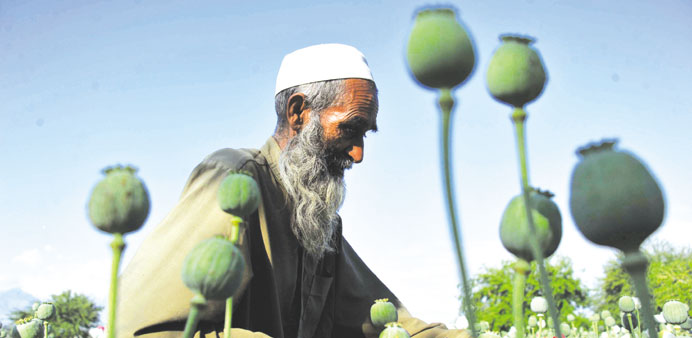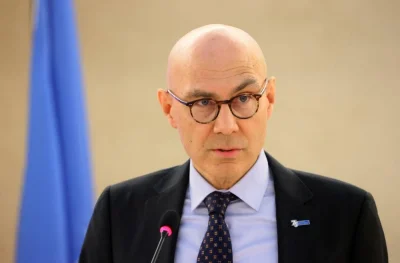An Afghan farmer collects raw opium as he works in a poppy field in Khogyani District of Nangarhar province.
Opium poppy cultivation in Afghanistan reached a record high in 2013 as farmers seek to “insure” themselves before Nato forces withdraw next year, the United Nations said yesterday.
The area planted with poppy rose by 36 percent in 2013, the UN Office on Drugs and Crime (UNODC) said in its annual report on Afghanistan, while production of opium, the main ingredient in heroin, jumped almost 50 percent compared with last year.
There are fears that the departure of most of the US-led Nato troops, who currently number around 75,000, by the end of 2014 will throw the war-torn nation into chaos.
“Farmers may have driven up cultivation... trying to shore up their assets as insurance against an uncertain future, which could ensue from the withdrawal of international troops next year,” the UNODC said.
More than a decade of Western-backed efforts to eradicate opium production have had limited success and farmers in two previously “poppy-free” provinces in the north began growing the crop in 2013.
Afghan officials blamed insecurity as the main factor behind the surge, which has continued for a third straight year.
“More than half of the opium cultivation takes place in Helmand,” Din Mohamed Mubarez Rashidi, the acting Afghan counter-narcotics minister, told a news conference.
Helmand in the south is one of the most troubled regions in Afghanistan where the Taliban are most active.
“Taliban and Al Qaeda encourage farmers to cultivate and protect their crops,” the minister said.
Rashidi, recently appointed by President Hamid Karzai to the post, said he was determined to fight opium cultivation including the “use of force to prevent cultivation”.
The report said that in 2013 the area under opium poppy cultivation rose to 209,000 hectares from the previous year’s total of 154,000 -- higher than the previous peak of 193,000 hectares in 2007.
Opium production reached 5,500 tons, up by almost half from 2012 but lower than the 2007 high of 7,400 tonnes as bad weather in southern Afghanistan affected crops.
The farm-gate value of opium production -- around $950mn, or the equivalent of four per cent of national GDP in 2013 -- increased by almost a third.
Together with profits made by drug traffickers, the total value of the opium economy within Afghanistan was significantly higher, the report said.
It suggested the illicit economy would grow further while a slowdown of the legal economy was predicted in 2014.
“What is needed is an integrated, comprehensive response to the drug problem, embedded in a long-term security, development and institution-building agenda,” said UNODC executive director Yury Fedotov.
Despite the presence of tens of thousands of foreign troops since a US-led invasion ousted the Taliban in 2001, Afghanistan produces about 90 percent of the world’s opium.
Poppy farmers are taxed by the Taliban, who use the cash to help fund their insurgency against the government and Nato forces.
Most of the cultivation takes place in the southern and western provinces where the revolt is most active.
In Helmand province, the main poppy-producing region, the area under cultivation rose by a third in 2013. Neighbouring Kandahar, the birthplace of the Taliban, saw a 16 percent rise.
The poppies, which provide huge profits in one of the world’s poorest countries, also play a large part in the corruption that plagues Afghan life at every level.



